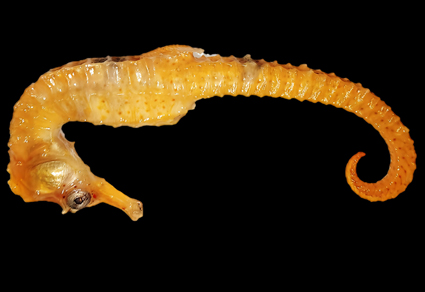Abstract
The common seahorse, Hippocampus kuda, is widely distributed throughout the Indo-Pacific region, occurring from East Africa to Hawaii, where it typically inhabits diverse ecosystems such as estuaries, lagoons, coastal zones, and seagrass beds. Despite its extensive geographic range, reports of its occurrence in the Red Sea remains limited, primarily restricted to the northern region of the Red Sea. Here, we report a new distributional record of H. kuda in Saudi Arabian waters within the south-central Red Sea. A single female specimen of H. kuda was collected through trawling conducted off the coast of Al Qunfudah at depths ranging from 15 to 20 meters. Morphological and molecular examination confirmed the identity of the specimen as H. kuda. The new record of H. kuda represents the second occurrence of this species in south-central Red Sea and expands its known distribution range 367 kilometers further south than the first reported record off Jeddah in 1838.
References
- Choo, C.K. & Liew, H.C. (2003) Spatial distribution, substrate assemblages and size composition of sea horses (Family Syngnathidae) in the coastal waters of Peninsular Malaysia. Journal of the Marine Biological Association of the United Kingdom, 83 (2), 271–276. https://doi.org/10.1017/S0025315403007069h
- CITES (2003) Proposals for amendment of Appendices I and II at 12th meeting of Conference of the Parties—results. CITES Secretariat, Geneva. [unknown pagination]
- Dody, S., Manuputty, G.D. & Limmon, G.V. (2021) Habitat characteristics and density of spotted seahorse Hippocampus kuda at waters of Ternate Island and surroundings, Maluku Utara, Indonesia. In: IOP Conference Series: Earth and Environmental Science. Vol. 805. No. 1. IOP Publishing, Bristol, 012006. https://doi.org/10.1088/1755-1315/805/1/012006
- GBIF.org (2024) GBIF Occurrence Download. Available from: https://doi.org/10.15468/dl.w3u6c9 (accessed 8 April 2024)
- Hamilton, D.J., Wheeler, D.W., White, C.M., Rees, C.L., Komendantov, A.O., Bergamino, M. & Ascoli, G.A. (2017) Name-calling in the hippocampus (and beyond): coming to terms with neuron types and properties. Brain Informatics, 4 (1), 1–12. https://doi.org/10.1007/s40708-016-0053-3
- IUCN (2004) 2004 IUCN Red List of Threatened Species. The World Conservation Union, Gland. Available from: https://www.iucnredlist.org/ (accessed 30 July 2024)
- iNaturalist (2024) Available from: https://www.inaturalist.org (accessed 30 April 2024)
- Kalisiak, J., Gray, I., Bruget, R. & Correia, M. (2022) The use of non-invasive sampling to estimate long-term abundance of Hippocampus kuda in the Koh Sdach Archipelago, Cambodia. Cambodian Journal of Natural History, 47–58.
- Kumar, S., Nei, M., Dudley, J. & Tamura, K. (2008) MEGA: a biologist-centric software for evolutionary analysis of DNA and protein sequences. Briefings in bioinformatics, 9 (4), 299–306. https://doi.org/10.1093/bib/bbn017
- Lipton, A.P. & Thangaraj, M. (2013) Distribution pattern of seahorse species (Genus: Hippocampus) in Tamilnadu and Kerala coasts of India. Notulae Scientia Biologicae, 5 (1), 20–24. https://doi.org/10.15835/nsb518298
- Lourie, S.A., Foster, S.J., Cooper, E.W. & Vincent, A.C. (2004) A guide to the identification of seahorses. Project Seahorse and TRAFFIC North America, 114 (1), 1–120.
- Lourie, S.A., Pollom, R.A. & Foster, S.J. (2016) A global revision of the seahorses Hippocampus Rafinesque 1810 (Actinopterygii: Syngnathiformes): taxonomy and biogeography with recommendations for further research. Zootaxa, 4146 (1), 1–66. https://doi.org/10.11646/zootaxa.4146.1.1
- Mehanna, S.F. & Al-Mahdawi, G.J. (2006) First record for syngnathid species (seahorses and pipefishes, Family: Syngnathidae) from Yemeni coast of the Red Sea. African Journal of Biological Sciences, 2 (2), 121–128.
- Rüppell, W.P.E.S. (1840) Neue Wirbelthiere zu der Fauna von Abyssinien gehörig Fische des Rothen Meeres. S. Schmerber, Frankfurt am Main, 40 pp., 14 taf, 116 pp., 42 taf, 18 pp., 6 taf, 148 pp., 33 taf.


